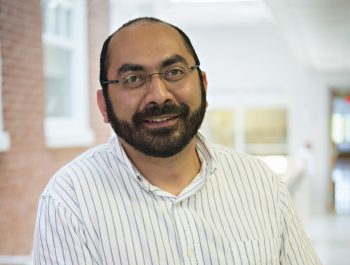Using Machine Learning to Track COVID-19 Moataz Khalifa, assistant professor and director of Data Education, is collaborating on a non-invasive, early detection system of the virus.
“Working on a real-life project that will introduce students to how algorithms work in applications with crucial outcomes will provide them with the important skills that can transfer to other areas of computer and data science.”
~ Moataz Khalifa
As the race for a COVID-19 vaccine continues, Moataz Khalifa, assistant professor and director of Data Education at Washington and Lee University, is involved in an equally promising research project that focuses on a non-invasive, early detection system of the virus.
In March, just as the numbers of cases were climbing around the world, Khalifa was invited by Wu Feng, Elizabeth & James Turner Fellow, professor of computer science at Virginia Tech and director of its SyNeRGy lab, to join his research lab to develop a deep-learning algorithm to enhance low-radiation CT scans of people’s lungs. Feng’s current research was already investigating similar applications in CT scans of brain tumors, and he received two National Science Foundation grants totaling $250,000 to expand his project to work on the COVID-19 early detection system.
Currently, the genetic-based RT-PCR tests available to detect COVID-19 rely on swabbing the nasal cavity. With testing kits in short supply, accuracy of the results only around 59%, and increasingly long processing times of 10 to 14 days, the hunt was on for a system that was more accurate, available and faster to handle the growing demand for tracking infections.
Feng is excited to have Khalifa, who earned his Ph.D. in physics from Virginia Tech, join the team. “My expertise is in parallel and distributed computing, and there are intersections with respect to data analytics and machine learning that we’ve got going on in our labs. Moataz has the skill set to look at different mathematical models used to build an algorithm — to get inside the box — so that we can build the best medical imaging software system possible.”
CT scans, which combine X-rays and computers to capture 2-D cross-sectional images of the body, are able to detect the existence of COVID-19 through certain markers in the lungs. The initial studies from China and Europe on which Feng’s team is building its research indicate that “the detection using CT scans is possible in asymptomatic people and with higher accuracy (upwards of 90%) than any other test available,” Khalifa said.
The barrier is getting people to the hospital for testing, but with a portable CT scanner, the testing can travel to where it’s needed, whether that be a college campus or an office complex. Portable scanners generally use less radiation and hence provide lower-resolution images. The algorithm Khalifa is working to modify will help enhance the quality of the images, improving the accuracy of detecting the coronavirus in its early stages. Another upside is that hundreds of people can be scanned a day, with results essentially available in real-time.
As the project moves forward, Khalifa will bring W&L undergraduates onto the research team. He noted that “artificial intelligence and machine learning is a hot area right now. Working on a real-life project that will introduce students to how algorithms work in applications with crucial outcomes will provide them with the important skills that can transfer to other areas of computer and data science.”
Khalifa added, “W&L’s collaboration with Virginia Tech is a strong and mutually beneficial one, bringing us to the front lines of this fight against COVID-19. I cannot say enough about how exciting it is to be a part of it and to bring our university even closer to such a critical contribution during these times.”
If you know any W&L faculty who would be great profile subjects, tell us about them! Nominate them for a web profile.
 Moataz Khalifa
Moataz Khalifa
You must be logged in to post a comment.